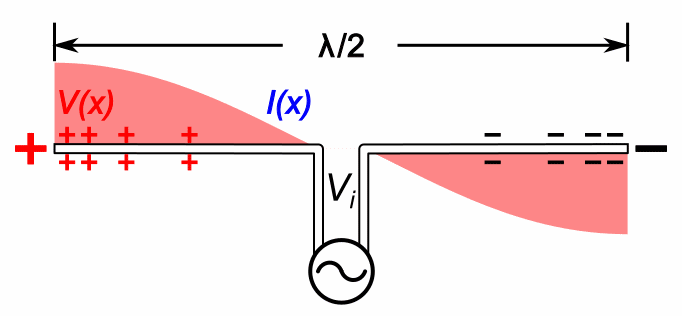Ӳкерчĕк:Dipole antenna standing waves animation 6 - 5fps.gif
Dipole_antenna_standing_waves_animation_6_-_5fps.gif ((682 × 316 пиксел, файл пысăкăше: 188 Кб, MIME-тĕсĕ: image/gif), циклланса ларнӑ, 20 фрейм, 4,0 с)
Ку файлпа, на Викискладе илнӗскерпе, ытти проектсенче усӑ курма пултараҫҫӗ. Унӑн страницӑри ӑнлантарӑвӗпе аяларах паллаштарнӑ.
Кĕскен ăнлантарни
| ӐнлантарниDipole antenna standing waves animation 6 - 5fps.gif |
English: Animation showing standing waves on a half-wave dipole antenna driven by a sinusoidal voltage Vi from a radio transmitter at its resonant frequency. The oscillating voltage pushes the electrons back and forth along the two metal rods that make up the antenna, creating oscillating currents (blue arrows) in the antenna, charging its ends alternately positive (+) and negative (-). Since at this frequency the antenna is a half wavelength (λ/2) long, a sinusoidal wave of voltage or current takes exactly one cycle to make the round trip from one end of the antenna to the other and back, so the reflected waves reinforce each other. The antenna acts like an electronic resonater. Waves of current and voltage reflecting back and forth between the ends of the rods interfere to form standing waves, which radiate radio waves into space. The waves are shown graphically by bars of color (red for voltage V(x) and blue for current I(x)) whose width at each point is proportional to the amplitude of the wave at that point. The blue arrows show the direction of conventional current, flow of positive charge. The electrons oscillating back and forth in the antenne move in a direction opposite to the arrows. The action is shown slowed down enormously; the currents in an actual antenna oscillate back and forth 20 thousand to one billion times per second.  between the two antenna elements, driving the oscillations. The energy from this current provides the energy lost in the antenna' s radiation resistance which represents the energy radiated as radio waves. Since the antenna is fed at its resonant frequency, the input voltage is in phase with the current (blue bar), so the antenna presents a pure resistance to the feedline. Dipoles have relatively high Q factor so the amount of energy stored in the standing waves is large compared to the energy added each cycle by the feedline, the feed voltage just represents a small perturbation to the standing waves. This is why the voltage standing wave is much larger than the voltage step at the feedline. Since the standing waves are storing energy, not transporting power, the current in them is not in phase with the voltage but 90° out of phase between the two antenna elements, driving the oscillations. The energy from this current provides the energy lost in the antenna' s radiation resistance which represents the energy radiated as radio waves. Since the antenna is fed at its resonant frequency, the input voltage is in phase with the current (blue bar), so the antenna presents a pure resistance to the feedline. Dipoles have relatively high Q factor so the amount of energy stored in the standing waves is large compared to the energy added each cycle by the feedline, the feed voltage just represents a small perturbation to the standing waves. This is why the voltage standing wave is much larger than the voltage step at the feedline. Since the standing waves are storing energy, not transporting power, the current in them is not in phase with the voltage but 90° out of phase |
| Дата | |
| Ҫӑлкуҫ | Хӑвӑрӑн ӗҫ |
| Автор | Chetvorno |
| Другие версии |
Dipole antenna standing waves animation 1-10fps.gif - less detail Dipole antenna standing waves animation 6-10fps.gif - faster frame rate |

|
This circuit image could be re-created using vector graphics as an SVG file. This has several advantages; see Commons:Media for cleanup for more information. If an SVG form of this image is available, please upload it and afterwards replace this template with
{{vector version available|new image name}}.
It is recommended to name the SVG file "Dipole antenna standing waves animation 6 - 5fps.svg" - then the template Vector version available (or Vva) does not need the new image name parameter. |
Лицензилени
| Этот файл доступен на условиях Creative Commons CC0 1.0 Универсальной передачи в общественное достояние (Universal Public Domain Dedication). | |
| Лица, связанные с работой над этим произведением, решили передать данное произведение в общественное достояние, отказавшись от всех прав на произведение по всему миру в рамках закона об авторских правах (а также связанных и смежных прав), в той степени, которую допускает закон. Вы можете копировать, изменять, распространять, исполнять данное произведение в любых целях, в том числе в коммерческих, без получения на это разрешения автора.
http://creativecommons.org/publicdomain/zero/1.0/deed.enCC0Creative Commons Zero, Public Domain Dedicationfalsefalse |
Краткие подписи
Элементы, изображённые на этом файле
изображённый объект вырӑс
создатель вырӑс
У этого свойства есть некоторое значение без элемента в
31 Юпа уйӑхӗн 2020
MIME-тип вырӑс
image/gif
Файл историйĕ
Вӑхӑт ҫине пуссан, ун чухнехи версине пӑхма пулать.
| Дата/Вăхăт | Миниатюра | Калӑпӑш | Хутшăнакан | Асăрхав | |
|---|---|---|---|---|---|
| хальхи | 13:01, 31 Юпа уйӑхӗн 2020 |  | 682 × 316 (188 Кб) | Chetvorno | Uploaded own work with UploadWizard |
Файлпа усă курни
Ку файлпа ҫак 1 страницӑра усӑ курнӑ:
Файлпа глобаллӑ усӑ курасси
Ку файлпа ҫак викисенче усӑ курнӑ:
- en.wikipedia.org усӑ курасси
Метаданнăйсем:
Файлта цифра камерӑсем е сканерсем хушакан хушма даннӑйсем пур. Хатӗрленӗ хыҫҫӑн файла редакциленӗ пулсан хӑш-пӗр параметрсем хальхи сӑнрипе пӗр килмесӗр пултараҫҫӗ.
| Примечание GIF-файла | PhotoScape |
|---|

